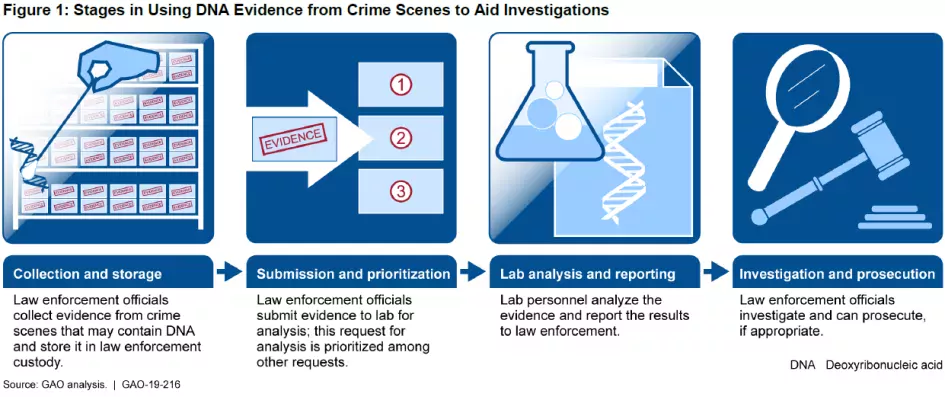Some Sexual Assault Kits Aren’t Sent to Crime Labs. Why not?
Evidence in sexual assault kits can be a powerful tool to help find and prosecute perpetrators of sex crimes and other crimes. Yet, evidence collected in thousands of sex assault kits hasn’t been turned over to crime labs for analysis.
Today’s WatchBlog explores this issue. Also, listen to our podcast featuring Gretta Goodwin, a director in our Homeland Security and Justice team, for more on the related issue of DNA evidence backlogs at labs.
What is in a sexual assault kit?
A sexual assault kit is a package of evidence collected by a medical professional from a victim’s body after unwanted sexual contact, including rape.
Kits generally include collection envelopes for biological materials (e.g., blood, semen, hair), debris, and underwear.
How sexual assault kits aid investigations
Investigators or prosecutors can ask labs to analyze evidence in the kits to help with investigations. Here‘s how it works:
- Labs recover a perpetrator’s DNA profile (think puzzle piece) from a sexual assault kit and upload it into a DNA database.
- The database compares the DNA profile to other profiles already in the system (or in other databases). Profiles already in these databases come from (1) evidence from other crimes or (2) DNA samples that law enforcement collect from people arrested or convicted of crimes, as provided by law.
- The comparison may result in a match (like finding two or more identical puzzle pieces). Since no two individuals have the same DNA (except identical twins), a match means that the perpetrator may be responsible for one or more additional crimes.
- Labs provide police with the relevant information.
Why sexual assault kits go unsubmitted for DNA analysis
There are several reasons investigators and prosecutors may not submit sexual assault kits. For instance:
- DNA evidence may not be needed to solve a crime
- A suspect may have already admitted to a sexual encounter so DNA analysis won’t be needed to identify him or her
- Investigators may question the circumstances of the case or the victim’s credibility and therefore choose not to submit a kit to a lab
The scale of the issue
The exact number of unsubmitted kits nationwide is not known. There are thousands of law enforcement agencies across the country, and not all of them keep meticulous inventories of kits. However, there are a few large-scale efforts to count unsubmitted kits nationwide, such as a DOJ grant program called the Sexual Assault Kit Initiative.
In recent years, the Department of Justice, the International Association of Chiefs of Police, and the National Sheriffs’ Association have recommended that all kits be analyzed if victims report the crime to law enforcement. And, as of September 2018, we identified at least 27 states that require law enforcement to submit kits that come into their possession for DNA analysis. Eleven of these states also require that previously unanalyzed kits be submitted.
See our full report for more information about this important issue, including:
- Additional reasons why investigators and prosecutors may not submit kits;
- A detailed explanation of how DNA databases allow federal, state, and local labs to exchange and compare DNA profiles;
- Data on the number of investigative leads developed through lab analysis, and associated arrests and convictions; and
- Additional reasons why there is no definitive nationwide count of unsubmitted kits.
Comments on GAO's WatchBlog? Contact blog@gao.gov
GAO Contacts
Related Products

GAO's mission is to provide Congress with fact-based, nonpartisan information that can help improve federal government performance and ensure accountability for the benefit of the American people. GAO launched its WatchBlog in January, 2014, as part of its continuing effort to reach its audiences—Congress and the American people—where they are currently looking for information.
The blog format allows GAO to provide a little more context about its work than it can offer on its other social media platforms. Posts will tie GAO work to current events and the news; show how GAO’s work is affecting agencies or legislation; highlight reports, testimonies, and issue areas where GAO does work; and provide information about GAO itself, among other things.
Please send any feedback on GAO's WatchBlog to blog@gao.gov.






